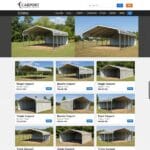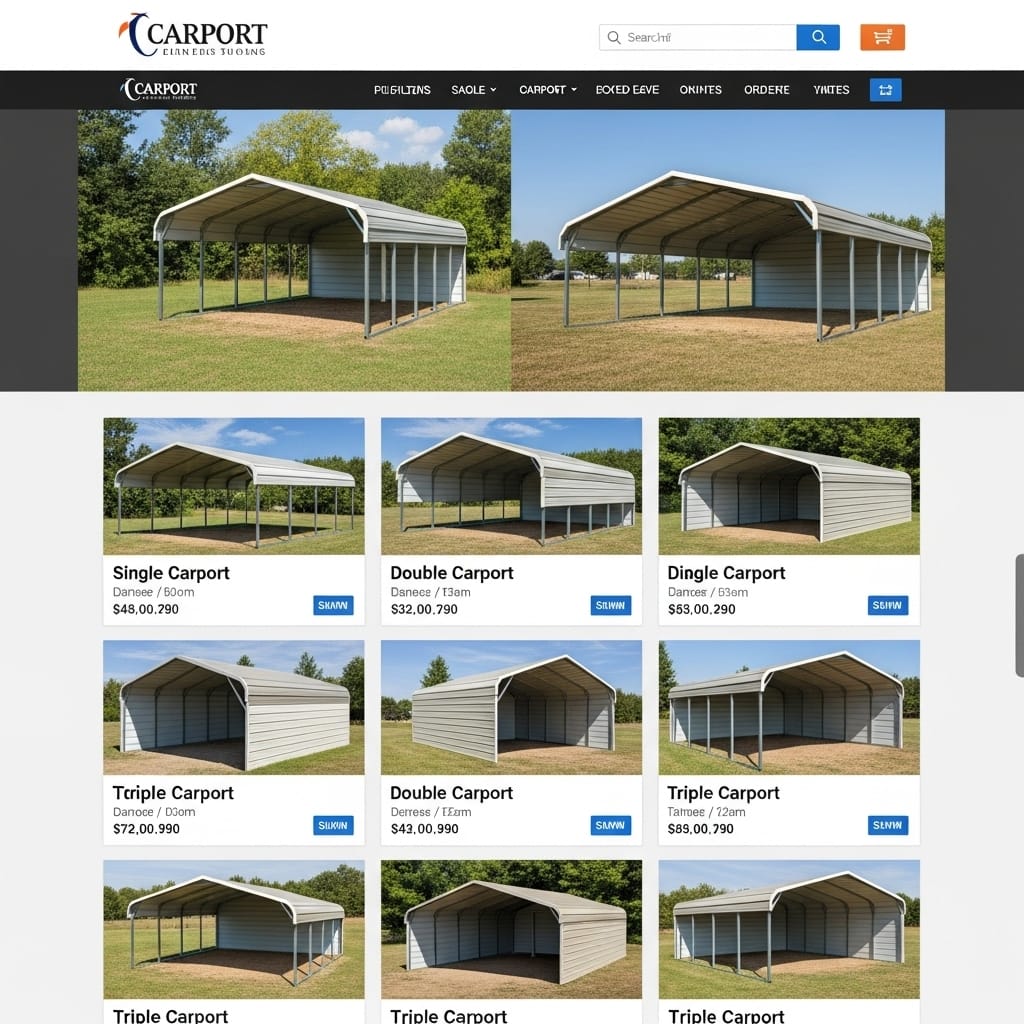
The Ultimate Guide to Carports for Sale: Protect Your Investment and Upgrade Your Property
In the vast landscape of home improvement, some additions offer quiet, unassuming value, working tirelessly behind the scenes to protect your biggest investments. The humble carport is a prime example. For far too long, it has been seen as a mere placeholder for a “real” garage. But to dismiss the modern carport is to overlook one of the most versatile, cost-effective, and intelligent upgrades you can make to your property. It’s more than just a roof on stilts; it’s a guardian for your vehicles, a versatile extension of your living space, and a smart financial decision.
Interestingly, the concept of the carport was championed by none other than the legendary architect Frank Lloyd Wright. He envisioned a structure that was lighter, more open, and more in harmony with a home’s design than a stuffy, enclosed garage. He saw it as a modern solution for a modern invention—the automobile. Today, that vision has evolved into a thriving industry offering an incredible array of carports for sale, designed to meet any need, budget, and climate. If you’re looking to protect your car, truck, RV, or boat, or simply expand your usable outdoor space, this comprehensive guide will walk you through everything you need to know.
Why a Carport is a Smarter Investment Than You Think
Before diving into the nuts and bolts of different styles and materials, let’s appreciate the fundamental value a carport brings. The most obvious benefit is protection, but the advantages run much deeper.

Superior Protection from the Elements
Your vehicle is constantly under assault from Mother Nature. A quality carport acts as a powerful shield against a host of damaging elements:
- The Sun: Relentless UV rays are your car’s worst enemy. They bake the interior, cracking dashboards and fading upholstery. They oxidize the paint, leading to a dull, chalky finish and eventual clear coat failure. A carport keeps your vehicle in the shade, preserving its interior and exterior, which directly impacts its resale value. It also means you won’t have to get into a scorching hot car on a summer afternoon.
- Rain and Hail: Acid rain can etch into your car’s finish, while hailstorms can cause thousands of dollars in damage in a matter of minutes. A carport provides a solid barrier, keeping your vehicle safe and dry. This also prevents water spots and makes it easier to keep your car clean.
- Snow and Ice: Anyone who has spent a frigid morning scraping thick ice off a windshield knows the value of covered parking. A carport prevents snow from piling up and ice from forming on your vehicle, saving you time and frustration during the winter months.
- Debris: From falling leaves and sticky tree sap to bird droppings and falling branches, a carport keeps all the messy and potentially damaging debris off your vehicle.
The Cost-Effective Alternative to a Garage
Let’s face it: building a traditional garage is a major construction project. It involves a poured concrete foundation, framing, insulation, drywall, electrical work, and a complex garage door system. The cost can easily run into the tens of thousands of dollars, and the project can take weeks or even months. A carport, on the other hand, delivers the core benefit—covered protection—at a fraction of the cost. Installation is also significantly faster, with many pre-fabricated metal carports being fully installed in a single day. This makes it an accessible option for a much wider range of homeowners.
Versatility and Multi-Purpose Use
A carport is a chameleon. While its primary job is to shelter vehicles, its open-air design and sturdy roof make it incredibly versatile. Homeowners across the country use their carports as:
- A Covered Patio: Place some outdoor furniture underneath, and you have an instant shaded area for barbecues, family gatherings, or simply relaxing with a book.
- A Workshop: It’s the perfect spot for DIY projects, providing shelter from the sun and rain while offering excellent ventilation that you wouldn’t get in an enclosed garage.
- An Outdoor Play Area: On a hot or rainy day, a carport can be a safe, protected space for kids to play.
- Storage: Beyond cars, it’s an ideal place to store boats, RVs, trailers, lawnmowers, and other large equipment that would otherwise clutter up your yard.
Decoding the Different Types of Carports: A Buyer’s Guide
The market for carports is diverse, with options to suit every climate, aesthetic preference, and functional need. Understanding the key differences in materials and roof styles is the most important step in choosing the right structure for your property.
Material Matters: Steel, Aluminum, and Wood
The material you choose will determine your carport’s durability, maintenance requirements, and overall cost.
- Steel Carports: By far the most popular choice in the USA, and for good reason. Steel is incredibly strong, durable, and relatively inexpensive. Modern steel carports use galvanized steel, which is coated in a layer of zinc to prevent rust and corrosion. The strength of the steel is measured by its gauge; a lower gauge number means thicker, stronger steel (e.g., 12-gauge is stronger than 14-gauge). Steel carports are ideal for all climates, especially those with high winds or heavy snowfall. They require virtually no maintenance and can be painted in a wide variety of colors to match your home.
- Aluminum Carports: Aluminum’s main advantages are that it’s lightweight and naturally rust-proof. This makes aluminum carports easier to handle and install, and they are a great choice for coastal areas with salty air. However, aluminum is not as strong as steel. It can be more susceptible to denting from hail and may not meet the snow load requirements of northern states. They are often a bit more expensive than their steel counterparts.
- Wood Carports: For those who prioritize aesthetics, nothing beats the natural beauty of wood. A wood carport can be custom-designed to perfectly match the architectural style of your home, creating a seamless and high-end look. However, this beauty comes with a price. Wood is typically the most expensive option and requires significant maintenance. It must be regularly stained, painted, or sealed to protect it from rot, warping, and insect infestations.
The Tale of Three Roofs: Regular, A-Frame, and Vertical
The roof style is arguably the most critical decision you’ll make, as it directly impacts the carport’s ability to handle your local weather conditions.
- Regular Roof Style: This is the most economical option available. It features rounded, barn-style corners and horizontally oriented roof panels. Because the panels run from front to back, they are best suited for areas with minimal rainfall and no snow. They provide excellent sun protection and are a great budget-friendly choice for southern climates.
- A-Frame / Boxed-Eave Roof Style: This style is a significant aesthetic upgrade. It features a pointed, A-frame roofline with a slight overhang on the sides, similar to a traditional house. This “boxed-eave” design is popular because it often blends in better with a home’s existing roofline. Like the regular style, the roof panels are installed horizontally. This makes it a great mid-range option for areas with moderate wind and rain, but it’s still not the best choice for heavy snow.
- Vertical Roof Style: This is the strongest, most durable, and most weather-resistant roof style you can get. It has the same A-frame design as the boxed-eave style, but the key difference is the orientation of the panels. The roof panels are installed vertically, running from the center peak down to the eaves. This seemingly small change has a massive impact. The vertical channels act like a slide, allowing snow, rain, ice, and debris to glide right off. This prevents weight from accumulating and causing a potential collapse. A vertical roof requires extra framing (hat channels) to support the panels, which adds to its strength and rigidity. If you live in an area with heavy snow or frequent, heavy rain, a vertical roof carport is not just a recommendation; it’s a necessity.
Before You Buy: The Essential Carport Checklist
You’ve explored the styles and materials, and you’re ready to find the perfect carport for sale. Before you make the call, run through this final checklist to ensure a smooth and successful purchase and installation process.
- Check Local Building Codes and Permits: This is the most important first step. Before you buy anything, contact your local city or county building department. Ask if a permit is required for a carport in your area. They will also inform you of any specific requirements, such as setback rules (how far the structure must be from property lines) and, crucially, any “snow load” or “wind load” ratings the structure must meet to be compliant. Knowing these ratings will help you and your dealer choose a certified carport that is engineered for your specific location.
- Prepare the Foundation: A carport must be installed on a level surface. You have several options for a foundation. You can pour a concrete slab, lay an asphalt pad, or create a level gravel base. Some carports can even be installed directly on level ground. A level site is non-negotiable; an unlevel installation will put stress on the frame and compromise the structure’s integrity.
- Understand Anchoring: Proper anchoring is what keeps your carport on the ground during a windstorm. The type of anchor used depends on your foundation. For ground or gravel installations, long, corkscrew-like mobile home anchors are used. For concrete, powerful expansion anchors are bolted directly into the slab. For asphalt, specialized asphalt anchors are required. Discuss the anchoring options with your dealer to ensure your carport is safe and secure.
- Choose the Right Size: Think about both your current and future needs. A standard carport for a single car is typically 12 feet wide. A double carport is usually 20 to 24 feet wide. When considering length, make sure it’s long enough to cover your entire vehicle, with a little extra room to walk around. For height, a standard carport has 6 or 7-foot legs, which is fine for cars and trucks. If you have an RV, camper, or large boat, you’ll need to look at specialized RV carports, which can have legs 12, 14, or even 16 feet tall.
- DIY vs. Professional Installation: Many carports are sold as kits for the handy homeowner to assemble. However, for a larger structure or for those who want peace of mind, professional installation is the way to go. The installation crews are experienced, efficient, and can often have the entire structure built in just a few hours. The cost of installation is often included in the purchase price, and it typically comes with a workmanship warranty.
Customization: Making Your Carport Your Own
Modern carports are not one-size-fits-all. You can customize them to perfectly suit your needs and aesthetic preferences. Consider adding partial or full side panels for extra protection from wind-blown rain. You can enclose the back end or even add gables to the front and back for a more finished, garage-like appearance. Most companies offer a wide palette of colors, allowing you to match your carport’s roof, trim, and walls to your home’s color scheme. You can even create a “utility carport” by fully enclosing a section in the back for a secure storage shed, giving you the best of both worlds.
Ultimately, a carport is a testament to practical ingenuity. It’s a simple solution to a common problem, executed with modern materials and smart design. It protects your valuable assets, enhances your property’s functionality, and does so without breaking the bank. By understanding the different types, preparing your site, and choosing a structure certified for your climate, you can invest in a carport that will serve you faithfully for decades to come.







